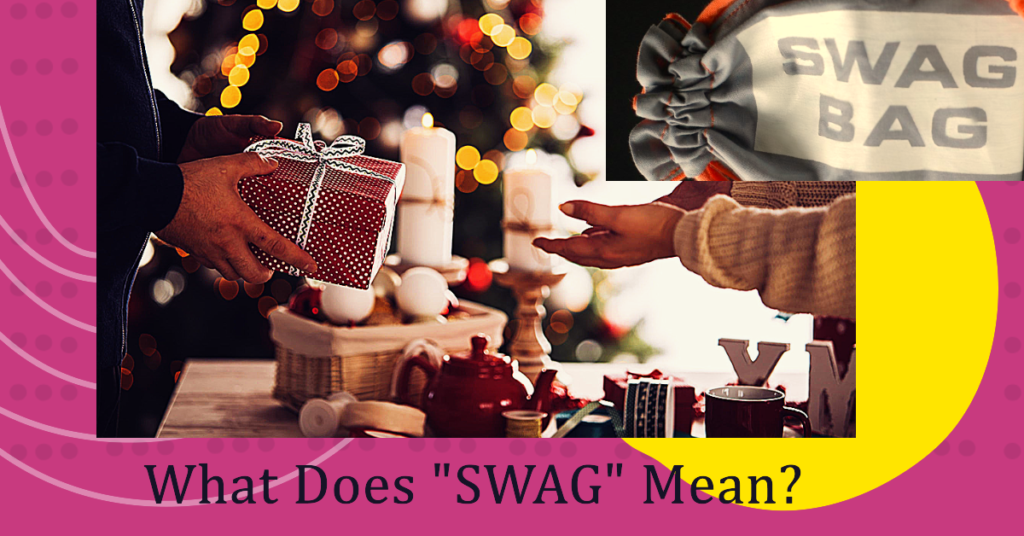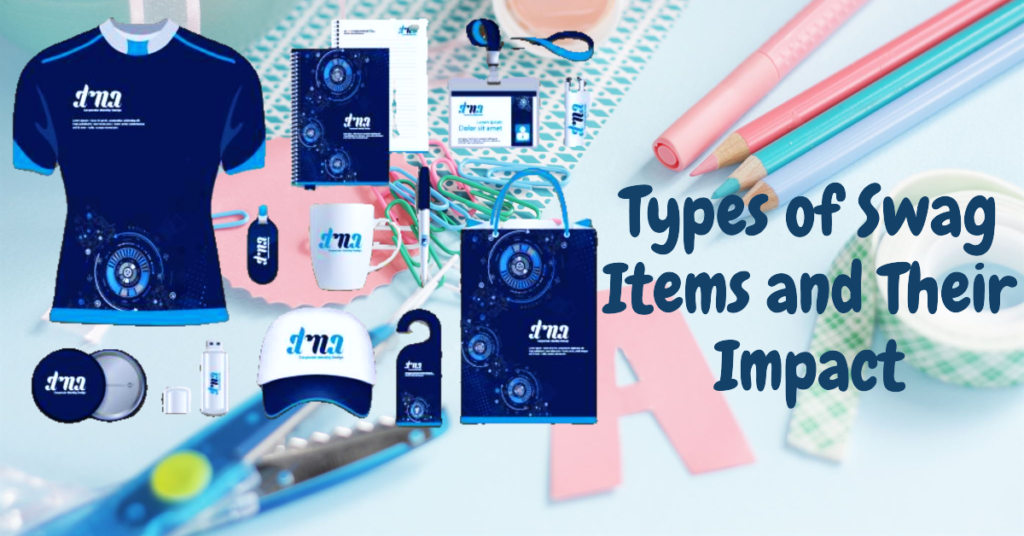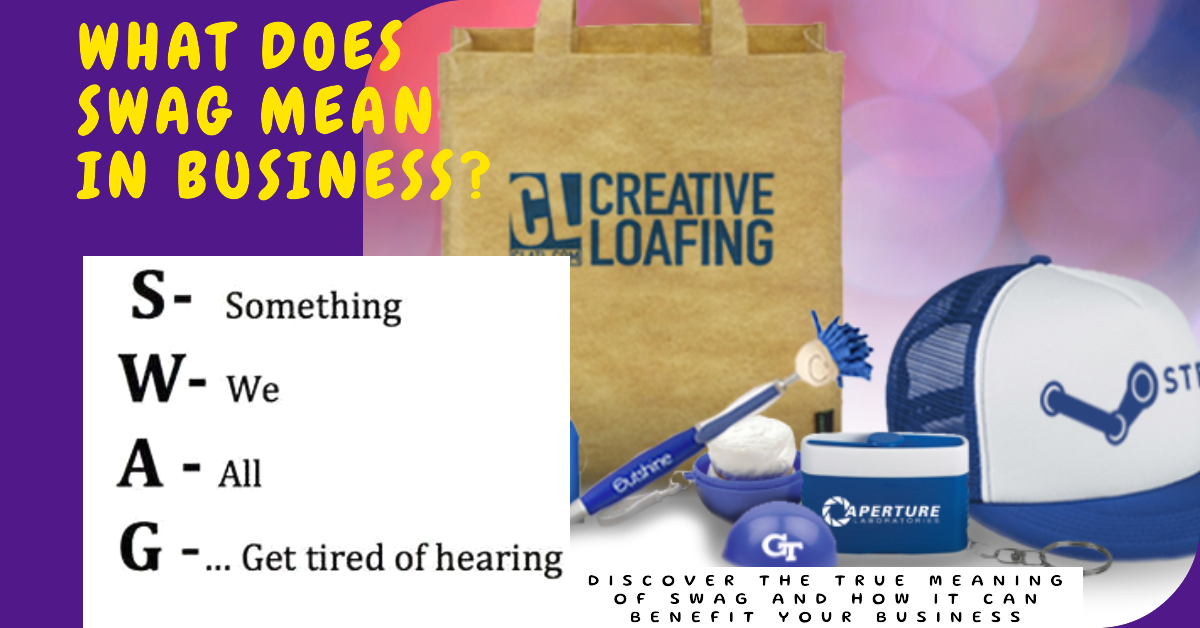In the dynamic realm of modern business, the quest to carve a niche and resonate with target audiences is ever-evolving. Being noticed in the competitive business environment is more important than merely a desire. Enter the realm of swag. But what does “swag” mean in business?
We are delving into a world of promotional products and branded merchandise that goes beyond mere giveaways. Swag, in its essence, is a tangible representation of a brand’s ethos, distributed at events or trade shows, aiming to amplify brand awareness and foster lasting business relationships.
From stylish branded apparel to practical drinkware adorned with a company’s logo, swag ‘stuff we all get ‘ serves as a bridge between businesses and their potential customers. This article offers an in-depth examination of leveraging swag strategically. Underscoring its ability to not only increase brand visibility but also to gain a solid presence in the market.
What Does “SWAG” Mean?
In the vibrant world of business, the term swag resonates with a unique charm. The term “swag” gets thrown around a lot, but what does it really mean? Swag definition refers to promotional products and branded merchandise that companies give out for free to customers, employees, or event attendees.

The word swag originated as an acronym for “Stuff We All Get.” It’s become associated with all the custom freebies that brands hand out to spread awareness and generate interest. Examples of swag items include t-shirts, hats, pens, and drinkware like water bottles and coffee mugs. Tech accessories like USB drives, and more, are all emblazoned with a company’s logo, colors, and graphics.
Beyond just promotional freebies, swag encompasses the bags, apparel, and other merch companies distribute at trade shows, conferences, or brand events. Attendees often get excited to score these limited edition branded items. Overall, swag serves as a tangible way for brands to gain mindshare and visibility.
Why Do Companies Use Swag in Marketing?
Swag is a vital marketing tool for brands for several key reasons:
- Brand Recognition: Swag serves as a constant visual reminder of a brand, enhancing its recall value.
- Cost-Effective Promotion: Swag offers tangible marketing at a fraction of the cost of traditional advertising methods to reach potential customers.
- Tangible Engagement: Physical items create a more personal connection than digital ads.
- Versatile Marketing: From trade shows to corporate events, swag fits seamlessly into various promotional strategies.
- Enhanced Business Relationships: Gifting swag fosters goodwill and strengthens ties with clients and employees.
- Feedback Channel: Swag can act as a conversation starter, opening doors to valuable customer feedback.
- Extended Reach: A well-chosen swag item can travel, spreading brand awareness beyond its initial recipient.
Benefits of Using Swag for Businesses
The strategic use of branded swag offers several advantages:
- Leave a Lasting Impression: Quality swag leaves a memorable mark, ensuring brands aren’t easily forgotten.
- Loyalty Boost: Customers appreciate freebies, often leading to increased brand loyalty.
- Viral Potential: Satisfied swag recipients often share their experiences, leading to organic brand promotional items.
- Diverse Branding Opportunities: Swag offers varied branding avenues from eco-friendly drinkware to tech gadgets.
- Data Collection: Events where swag is distributed can be goldmines for collecting potential customer data.
- Increased Sales: A well-strategized swag campaign can lead to a direct increase in sales.
- Elevated Employee Spirits: Beyond external branding, swag can uplift employee morale, fostering a positive work environment.
Types of Swag Items and Their Impact
Companies have a vast assortment of promotional merchandise to choose from when planning their swag offerings. Certain types of swag cater to specific audiences more effectively.

- Branded Apparel: T-shirts, hats, jackets, and other apparel are versatile swag options. Apparel makes walking billboards to boost brand visibility. Branded apparel is especially effective for consumer-focused companies targeting younger demographics.
- Drinkware: Water bottles, mugs, tumblers, and other drinkware enable useful branding. People often carry drinkware with them, expanding exposure. Drinkware resonates well with active, health-conscious audiences.
- Tech Accessories: Portable chargers, phone cases, earbuds, and other tech swag appeal to digitally engaged consumers. These are perceived as higher-value items. Tech swag helps companies position themselves as innovative.
- Promotional Office Supplies: Pens, notepads, sticky notes, and other practical office supplies make handy swag options. Office supplies tend to see regular use, amplifying brand impressions. This type of swag caters well to professional services firms targeting other businesses. The usefulness and versatility of branded office supplies make them universally appealing.
- Food-Related Swag: Edible swag offers include cookies, candy, coffee, snacks, and more. Consumable promos connect brands to moments of enjoyment and satisfaction. Food swag tends to attract attention due to its wide appeal. However, dietary restrictions should be considered when food swag is distributed. Ultimately, the right food swag can sweeten someone’s perception of a brand.
- Eco-Friendly Swag: Sustainable swag like reusable bags/bottles, bamboo products, or solar chargers align with green-conscious audiences. Beyond just branding, eco-swag shows social responsibility.
The most effective swag directly connects with a target demographic’s preferences. Additionally, useful and quality swag items tend to drive higher brand perceptions and sales interest. Aligning branded merchandise with a company’s objectives, audience, and messaging is key for optimizing swag campaigns.
How to Create Company Swag Your Customers Will Love
Creating branded swag that resonates with your target audience is key for amplifying your marketing. Follow these tips for swag people get excited about:
Choose Relevant, High-Quality Items:
- Carefully select swag items that align with your brand image and audience preferences.
- Prioritize useful, long-lasting products.
- Cheap swag may leave negative impressions.
- Invest in quality swag that provides value beyond branding.
Showcase Your Logo and Branding:
- Strategically incorporate your company logo, name, tagline, colors, and other branding elements.
- Consistent, prominent branding amplifies awareness. But avoid overcrowding products.
- Allow room for design elements and creativity.
Offer Functional, Practical Products:
- Choose swag your audience can benefit from using regularly.
- Picks like water bottles, notebooks, or phone accessories enable constant brand impressions through their utility.
- Helpful swag excites recipients.
Get Creative with Designs:
- Inject creativity into swag designs to spark interest.
- Clever graphics and memorable color schemes perform well.
- Holiday-themed or limited-edition swag builds anticipation and desirability.
Provide an Assortment of Swag:
- Develop a diverse mix of swag to suit different preferences.
- Offer apparel, office supplies, tech gear, eco-friendly items, and more.
- Variety helps you appeal to a broader audience with your swag initiatives.
With carefully chosen, brand-relevant swag that adds value, your business can cultivate stronger engagement and customer loyalty.
How to Execute a Successful Swag Marketing Strategy
In the world of marketing, swag holds a unique position. It’s tangible, memorable, and when done right, can be a powerful tool to enhance brand visibility. Here’s a deep dive into creating a swag marketing strategy that resonates and leaves a lasting impression. Follow these tips for swag success:
Brand Promotion at Events
Use branded swag to gain visibility at conferences, trade shows, and company events. Give away useful items like shirts, tumblers, and tech accessories. Tailor swag to event goals and audiences. On-theme swag attracts attention.
Surprise and Delight Customers
Strengthen relationships by surprising loyal customers and potential leads with swag gifts. Segment swag by demographics and interests for personalization. Time it for holidays or milestones.
Employee & Partner Reward
Show employee, partner, or influencer appreciation through swag rewards for tenure, referrals, or achievements. Choose motivating swag like gift cards, apparel, or high-end electronics.
Open an Online Swag Shop
Sell your branded merchandise through an e-commerce swag store. This enables broader access and incremental revenue. Offer discounts or free shipping to incentivize purchases.
Co-Branding Opportunities
Pursue co-branding arrangements with complementary brands. Collaborative swag collections can expand the visibility of both brands.
Allocate Budget Based on Goals
Carefully budget based on campaign scale, product costs, and distribution needs. Get supplier quotes and order samples to estimate spending. Negotiate bulk discounts.
Align Designs with Branding
Ensure swag aligns with brand guidelines. Test concepts before mass production. Choose styles and messaging that resonate with target demographics.
Distribute Strategically
Segment distribution by purchase history and demographics data. Giveaway extras at events. Time initiatives for holidays or campaigns. Refine logistics like inventory and fulfillment.
Measure Performance
Use surveys, promo codes, and analytics to quantify the impact on brand awareness, sales, and other KPIs. Continually optimize based on results.
In essence, swag marketing is more than just giving away branded items. It’s about creating experiences, fostering relationships, and building brand loyalty. With the right strategy, your swag can become the talk of the town, driving unparalleled brand engagement.
Future Trends in Swag Marketing
The world of swag marketing is constantly evolving. Brands are finding innovative ways to craft promotional products that drive impact. Key trends to expect include:
- Eco-friendly swag made of recycled, natural, or biodegradable materials will become more popular as brands seek to demonstrate social responsibility. Sustainable swag attracts environmentally conscious consumers.
- Personalized and customized swag tailored with names, photos, locations, or unique designs will gain traction through technologies like digital printing. Custom swag boosts recipient affinity.
- Augmented reality can bring swag to life digitally through interactive experiences on smartphones. AR enables gamification and virtual branded content.
- Swag mobile apps will allow brands to offer exclusive digital items, content, and utilities to deepen engagement beyond physical products.
- Smart swag integrated with technology like fitness trackers and Bluetooth speakers will facilitate interactive brand experiences and loyalty.
- On-demand product customization enables relevant, one-of-a-kind swag aligned with individual needs and interests.
- Unexpected and experiential swag that provides entertainment, adventures, or access will capture attention for being more than just merchandise.
As swag marketing advances, the focus will be on driving creativity, personalization, digital integration, and delivering ROI beyond just branding impressions.

Frequently Asked Questions – FAQs
Swag refers to free branded promotional items that companies distribute to boost awareness.
While swag is often said to stand for “Stuff We All Get,” its origins as an acronym are debated.
Building brand awareness and affinity.
Companies strategically give out swag like shirts and drinkware to build brand familiarity and affinity.
Swag began as slang but has become an established business marketing term.
Common swag includes branded apparel, office supplies, tech accessories, and drinkware.
With high-quality, stylish, or eco-friendly items.
Merchandise is sold, and swag is free promotions.
Swag denotes promotional goods, whereas SWOT is a strategic analysis tool that examines a company’s Strengths, Weaknesses, Opportunities, and Threats.
Bottom Line
Wrapping up, in today’s competitive business landscape, swag stands as a beacon of brand identity. It’s not merely “stuff we all get” or what it traditionally stands for “stuff”. It’s a meticulously crafted element of marketing efforts. Swag is not just another promotional tactic, it’s a strategic tool that bridges the gap between brands and their audiences.
Through successful swag campaigns, companies can broaden their impact, build brand awareness, and cultivate deeper connections. The art of distributing swag has evolved, with companies giving out swag that not only captures attention but also resonates with its intended audience. From promotional swag at bustling events to thoughtfully designed branded products, the potential to grow your business is immense.
Every piece of swag carries meanings depending on the context, making it a versatile tool to push the business forward. In essence, swag is a great way to engage and retain customers, serving as a testament to a brand’s commitment and vision in the modern business world.


1 thought on “What Does SWAG Mean in Business? Unlocking Opportunities!”